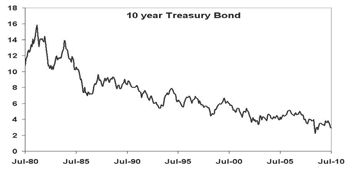 The slide in U.S. Government bond yields to below 3 percent during the recent stock market correction once again brings up the topic of whether global government debt is the next speculative bubble waiting to burst and disappoint investors. With the long-term average yield of U.S. 10-year bonds a little north of 5 percent and record highs in the mid-teens back in the early 1980s, it is easy to make the case that rates will rise from here. This would cause existing bond prices to drop and a large group of investors left to feel the pain once again. Here’s a chart showing this wild range of treasury bond yields over the last 30 years or so.
The slide in U.S. Government bond yields to below 3 percent during the recent stock market correction once again brings up the topic of whether global government debt is the next speculative bubble waiting to burst and disappoint investors. With the long-term average yield of U.S. 10-year bonds a little north of 5 percent and record highs in the mid-teens back in the early 1980s, it is easy to make the case that rates will rise from here. This would cause existing bond prices to drop and a large group of investors left to feel the pain once again. Here’s a chart showing this wild range of treasury bond yields over the last 30 years or so.
But one nagging issue has me wanting to re-think the situation. Speculative bubbles are rarely acknowledged by the majority until after they have been popped and then everyone likes to say, “See, I told you so." At present however, there is no shortage of advisors and investors predicting doom and gloom for those buying 10-year government debt and earning less than 3 percent annually. Their theory is that rates will have to rise over the coming years as the debts of developed world economies continue to build to support the economic stimulus and social safety net programs.
The logic is there, it makes sense, and in principal I am on board with the expectations principal I am on board with the expectations that interest rates must rise. Some of the smartest fund managers we know also subscribe to this theory and these are people with 40 plus years of experience in some cases. The question remains though, if so many expect this trend to begin in the near future, why is there such demand for long-term treasury bonds right now?
One possible explanation is that after two major stock market declines in 10 years and the worst real estate collapse in memory, investors are very gun shy and are plowing money into investments like treasury bonds more for safety than for profits. In other words they are more worried about “return of their capital” rather than the “return on their capital." History has shown this flight to safety to be a mistake in the long run, but nonetheless, you can understand it a bit when considering what investors have been through in the last decade.
The demand for safety has translated into a flood of investor dollars, both by individuals and institutions, which is keeping bond prices near record highs and corresponding bond yield rates at record lows. This benefits those wanting to borrow money, such as for a home mortgage, but hurts savers who use CDs, money markets, etc. to generate income.
The question is how long this condition will last. Many predict higher rates (and lower bond prices) in the next year or so. But playing devil’s advocate, I would point out that many predicted rising interest rates in Japan over the last 10 years. The predictions have not come to pass in the world’s second largest economy.
I think you have to be prepared for rising rates and falling bond prices at some point, but it may be a little early (judging by the popularity of the consensus opinion) to say it is an idea whose time has come. Stay flexible and don’t let predictions drive your investment process. Invariably, predictions are wrong at least 50 percent of the time.
Tom Breiter is president of Breiter Capital Management, Inc., an Anna Maria based investment advisor. He can be reached at 778-1900. Some of the investment concepts highlighted in this column may carry the risk of loss of principal, and investors should determine appropriateness for their personal situation before investing. Visit www.breitercapital.com.



 The slide in U.S. Government bond yields to below 3 percent during the recent stock market correction once again brings up the topic of whether global government debt is the next speculative bubble waiting to burst and disappoint investors. With the long-term average yield of U.S. 10-year bonds a little north of 5 percent and record highs in the mid-teens back in the early 1980s, it is easy to make the case that rates will rise from here. This would cause existing bond prices to drop and a large group of investors left to feel the pain once again. Here’s a chart showing this wild range of treasury bond yields over the last 30 years or so.
The slide in U.S. Government bond yields to below 3 percent during the recent stock market correction once again brings up the topic of whether global government debt is the next speculative bubble waiting to burst and disappoint investors. With the long-term average yield of U.S. 10-year bonds a little north of 5 percent and record highs in the mid-teens back in the early 1980s, it is easy to make the case that rates will rise from here. This would cause existing bond prices to drop and a large group of investors left to feel the pain once again. Here’s a chart showing this wild range of treasury bond yields over the last 30 years or so.